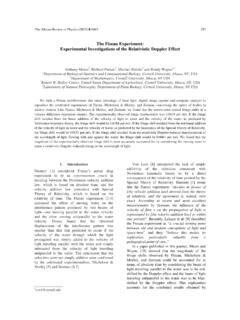Transcription of Development, Anatomy and Physiology of the Eye
1 77 Development, Anatomy and Physiology of the Eye The word perspective comes from the Latin per- through and specere look at . Last week we discussed vision from a historical perspective in order to understand how Johannes Kepler, Ren Descartes and Bishop Berkeley discovered the importance of the mind in effecting vision. Next we discussed image formation from a geometrical and analytical perspective in order to understand how Euclid, Ptolemy, Alhazen, Kepler, Snel and Descartes discovered how images were formed by reflecting and refracting elements, including metallic mirrors, glass lenses , and the proteinaceous cornea and crystalline lens of our eye. Today we will talk about the eye and its connections with the brain from the perspective of development, Anatomy and Physiology .
2 Our eyes develop to a large extent while we are in the womb from the fourth to the tenth week (28-70 days) following conception: ( ). 78 Following conception, the fertilized egg divides to form tissues that will connect the embryo to the mother, yolk cells that will give rise to the germ cells, and stem cells. The embryonic stem cells give rise to the three embryonic tissues. Our eyes have their origin in these three embryonic tissues: the lens and the cornea are derived from the ectoderm, the optic nerve, the retina and the epithelial layers of the iris and ciliary body are derived from the endoderm, and the rest is derived from the mesoderm. Approximately four weeks (28 days) after conception, the forebrain, which is derived from the endoderm and from which the optic nerve, the retina, and the epithelia of the ciliary body develop, pushes its way into the surrounding loosely-associated cells known as the mesochyme, which is derived from the mesoderm, to form the optic vesicles.
3 79 During the fifth week (35 days), as each optic vesicle grows, it makes contact with the thickened surface of the ectoderm known as the lens placode causing it to differentiate into the crystalline lens of the eye instead of skin epidermal cells. The contact is also accompanied by invagination of the optic vesicle into an optic cup where the lumen of the optic vesicle is reduced to a slit. The inner layer of the optic cup develops into the neural retina and the outer layer develops into the retinal pigmented epithelium. By the sixth week (42 days), the crystalline lens breaks free within the optic cup where it will continue to develop. 80 By the seventh week (49 days), the outer layer of the cornea differentiates from the ectoderm.
4 The mesenchyme surrounding the optic cup differentiates into the stroma of the cornea, the sclera and the choroid. 81 While the inner layer of the optic cup develops into the neural retina, the leading edge of the optic cup participates in the formation of the epithelial portion of the iris and the ciliary body. While most of the neural retina will differentiate into a layer of rods and cones, it will also differentiate into a layer of bipolar cells and a layer of ganglion cells. Some of the ganglion cells will extend towards the brain and differentiate into the optic nerve. We will talk about the retina in detail next week when we talk about color vision. Hans Spemann (1924) studied eye development and hypothesized that the optic cup acts as an organizer of the lens.
5 He proved the existence of organizers by doing tissue transplants and inducing tissues to develop into other tissues. Spemann won the Nobel Prize in 1935 for his work ( ). Below is a proposed model of the role of organizers, which are now known as localized inducing molecules or paracrine factors that may cause the differentiation of the crystalline lens, the retina, and the cornea. 82 During the eighth week (56 days), the stroma of the iris differentiates from mesochyme as the anterior and posterior spaces on either side of the iris fill with aqueous humor. We will talk about the iris in detail next week when we talk about eye color. The vitreous humor develops in the space between the crystalline lens and the neural retina.
6 At this stage, the retinal pigmented epithelium causes the eyes to be seen as small dark holes on either side of the head. By the ninth week (63 days), the eyelids are developed. The eyelids will stay closed from the third month until the seventh month (26 weeks). By the tenth week (70 days), although still developing, the eye looks very much like an adult eye. 83 During the sixteenth week (4 months), the retina and the neural connections to the brain are still developing. At six and one-half months, the eyes are still sealed-shut. African American, Hispanic and Asian babies are usually, although not always, born with brown eyes while Caucasian babies are usually born with blue eyes.
7 Babies do not always come out the way parents expect: Richie Lopez was born without eyes. His parents hope that he will get an eye transplant or eyes grown from stem cells. When a baby is born the rods are fully developed and the baby has low light black and white scotopic vision. Approximately three months later, the cones form and the baby also has photopic color vision. The retina is derived from the optic cup and some consider the retina to be a part of the brain, having been sequestered but not isolated from it early in development. Interestingly, the retina is only part of brain readily that is readily visible to us. It can be viewed with an ophthalmoscope. 84 Demonstration: View your classmate s retina with an ophthalmoscope.
8 The neural retina contains the light-sensitive photoreceptor cells, known as rods and cones. The rods and cones are modified cilia. The rods and cones are on the neural retinal layer closest to the retinal pigmented layer and farthest from the external world. The rods are very light sensitive and are involved in dark (scotopic) vision while the cones are less light sensitive and are involved in normal color (photopic) vision. Scotopic vision, effected by the rods is more efficient in utilizing light at low light intensities than photopic vision, effected by cones. Moreover the range of spectral colors utilized by the rods is blue-shifted relative to the range of spectral colors utilized by the cones.
9 Perhaps this is why objects illuminated by moonlight look black and bluish-white. 85 Remember from the Pulfrich pendulum effect, that when we use our scotopic vision, we see things in the past. Night lights in baseball stadiums allow players to play with their photopic vision, so they see, and catch or hit the ball in the present. The rods and cones are connected to bipolar cells which in turn are connected to retinal ganglion cells. The retinal ganglion cells are in the layer of the retina closest to the external world. The axons of the retinal ganglia pass through the retina at the optic disc to connect with the optic nerve. Since two cells cannot be in the same place at the same time, this precludes the photoreceptor cells from being in the optic disc, thus creating a blind spot on the nasal side of the retina.
10 The rods, which are used for scotopic vision, are located around the periphery of the retina. The most peripheral rods are capable of sensing motion but are not able to produce an image of what is moving. You can tell this by having a friend wave an object such as a fork or a spoon at the very edge of your visual field near your ear. You will be able to tell something is moving, and in which direction, but you will have no idea what is moving! 86 The cones that are involved in photopic color vision are enriched in the center of the retina known as the macula, which is mm in diameter. The macula is a region of the retina that is rich in retinal ganglion cells as well as cones.




